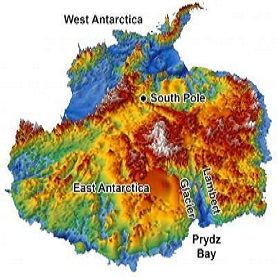
Like Alaska's mighty Yukon, a broad river once flowed across Antarctica, following a gentle valley shaped by tectonic forces at a time before the continent became encased in ice. Understanding what happened when rivers of ice later filled the valley could solve certain climate and geologic puzzles about the southernmost continent.
The valley is Lambert Graben in East Antarctica, now home to the world's largest glacier. Trapped beneath the ice, the graben (which is German for ditch or trench) is a stunning, deep gorge. But before Antarctica's deep freeze 34 million years ago, the valley was relatively flat and filled by a lazy river, leaving a riddle for geologists to decode: How did Lambert Graben get so steep, and when was it carved?
The key to Lambert Graben's history was found in layers of sediments just offshore, in Prydz Bay. In a new study, Stuart Thomson, a geologist at the University of Arizona (UA) in Tucson, looked into the past by decoding sands deposited by the river, and the messy piles left behind by the glacier. The river sands are topped with a thick layer of coarser sediment that signals the onset of glacial erosion in the valley, the researchers found. The erosion rate more than doubled when the glaciers moved in, Thomson said.
"The only way that could happen is from glaciers," he said. "They started grinding and forming deep valleys."
Understanding when glaciers first wove their way across Antarctica will help scientists better model the ice sheet's response to Earth's climate shifts, the researchers said.
"There's a big effort to model how glaciers flow in Antarctica, and these models need a landscape over which glaciers can flow," Thomson told OurAmazingPlanet. "Once these models can predict past changes, they can more accurately predict what will happen with future climate changes."
The sediments also hold clues to the tectonic evolution of East Antarctica, and a mountain range buried beneath the vast, thick ice sheet. [Album: Stunning Photos of Antarctic Ice]
The findings are detailed in the March 2013 issue of the journal Nature Geoscience.
History of the ice
Lambert Graben formed during the breakup of Gondwana, an ancient supercontinent, a process that happened in stages. Antarctica, India and Africa tore apart in the Late Cretaceous (about 80 million years ago). The split created long, linear valleys oriented perpendicular to the continental coastlines. At the time, Earth's climate was warmer than it is today, and as Antarctica moved southward, settling into its home over the South Pole, the continent teemed with plants and animals.
Scientists can partially reconstruct this past environment with fossils and through radar that peers beneath the ice to map the shapes of the rock below. A 3D map of Antarctica today shows chasms carved by glaciers, rugged mountains and other remnants of its warmer existence.
But the surveys tell nothing about how the landscape looked before the ice carved out all those features. "People have speculated when the big fjords formed under the ice," Thomson said. "But no one knows for sure until you sample the rocks or the sediments."



Reader Comments
to our Newsletter